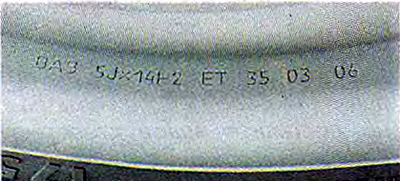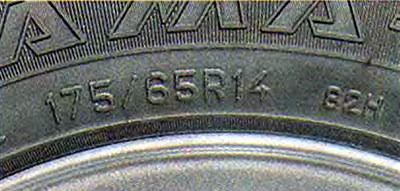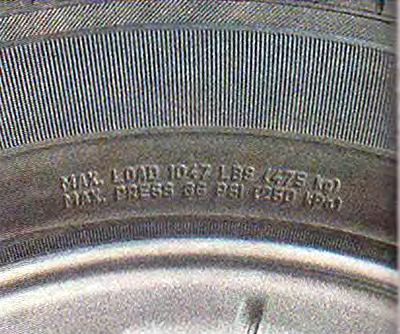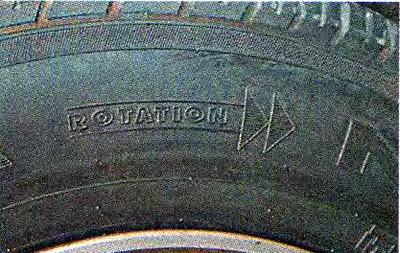- 5 (51 /2) - rim width in inches;
- J - symbol of the rim profile;
- 13 (14) - landing diameter of the rim under the tire in inches;
- H2 - conventional designation of the shape of the landing flanges of the rim;
- ET - symbol for rim offset;
- 35 - rim offset in millimeters.

Note. Rim offset (ET) is the distance between the plane dividing the wheel rim in half (plane equidistant from the rim flanges), and mating (fixing) wheel plane.
The car is equipped with tubeless tires 175/70R13 82T (or H), 175/65R14 82H or 185/60R14 82H, where:
- 175 (185) - profile width in millimeters;
- 65 (60) - the ratio of the profile height to its width in percent;
- R - designation of the radial tire;
- 14 - tire diameter in inches;
- 82 - load index (maximum allowable tire load 475 kgf);
- T (H) - speed index (the maximum allowable speed is 190 and 210 km/h respectively).

Maximum tire load (MAX LOAD) duplicated in deciphered form, together with an indication of the maximum allowable pressure (MAX AT) air in the tire.

It is also allowed to install tires with a landing diameter of 14 inches and a speed index T on the car.
Giving recommendations in the choice of certain tires, the manufacturer proceeds from the conditions for ensuring maximum stability, handling, patency and safety of the car. So, wheels with a long reach can touch the parts of the brake mechanisms, and with a smaller one, they increase the load on the hub bearings and can lead to unpredictable behavior of the car during emergency braking or in the event of a failure of one of the brake system circuits. High-profile tires can rub against body parts at maximum suspension travel, while wide tires can rub against the car's side members or fenders at high steering angles. A tire with a lower load index may burst under the maximum load of the vehicle, and an underestimation of the speed index is fraught with destruction of the tire when driving at high speed.
Tires that can be installed on a car are divided into three types: summer, winter and all-weather. If the car is operated all year round, and the winter is snowy, then it is better to have two sets of wheels: with winter and summer tires. Winter tires are made without softer rubber, which allows them not to «petrify» at negative temperatures, and on the tread there are narrow wavy slots - lamellae. This allows the tire to better cling to the roughness of the coating. Winter tires may have M+S or MS on their sidewalls. Keep in mind that studs are designed to improve traction only on slippery hard surfaces such as ice or packed snow. In other cases, the spikes are useless, and on asphalt they even slightly worsen the grip of the tire with the road.
The use of a winter tire in the summer leads to intensive wear.
All season tires can be used all year round. They are distinguished from other tires by the inscription ALL SEASON or TOUS TERRAIN on the Sidewall. According to their performance «they behave satisfactorily in various weather conditions, but at the same time they lose in terms of technical indicators to summer tires in summer, and winter tires in winter.
The tread pattern can be universal or directional and is not regulated by the manufacturer's requirements. With a directional tread pattern, ROTATION and an arrow are applied to the sidewall of the tire, indicating the direction of rotation of the wheel when the vehicle moves forward. A special case of a directional pattern is asymmetric. In this case, the inscription OUTSIDE is applied on the sidewall, which must be on the outside during installation.

